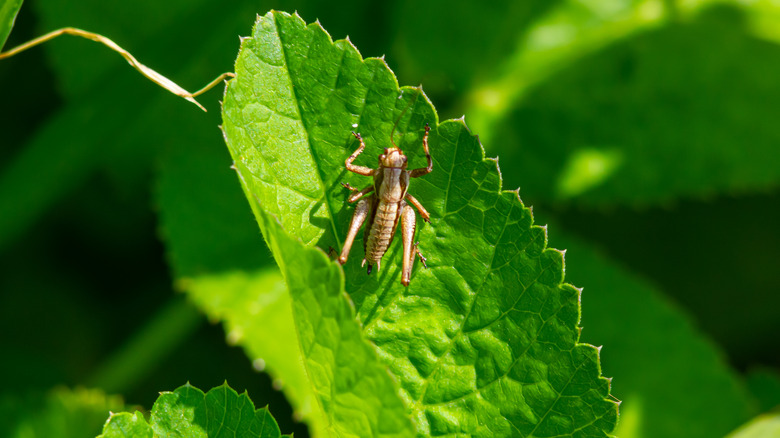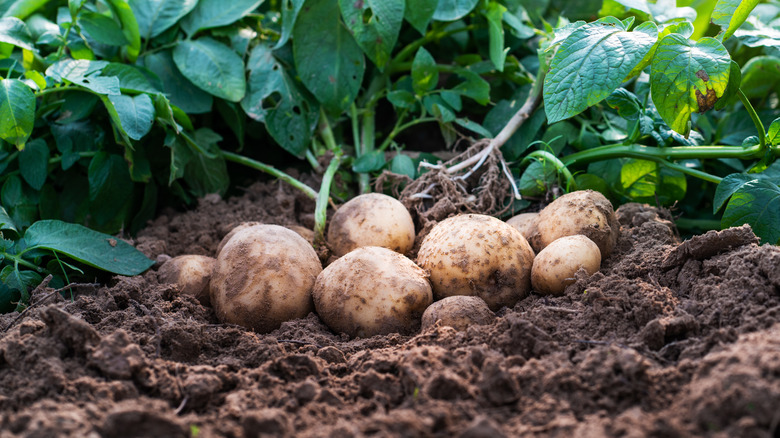The Gardening Mistake That's Secretly Attracting Crickets To Your Yard
Male crickets' night courtship or territorial calls have probably made you think, "Ugh! Not in my yard." But sure enough, it was your yard, and it's now missing sundry vegetable seedlings. If the damage hasn't clued you in on your gardening mistake, here it is: you've been growing crops that attract crickets. Mole crickets, especially their introduced (non-native) varieties, such as shortwinged and tawny, prefer plants over insects to meet their food needs. The mere sight of tomatoes, peppers, eggplants, pigweeds, and strawberries is enough to get their hearts racing, not that they make any exceptions for flowering plants. Rarely, field crickets may also gorge on cotton and alfalfa.
However, crickets aren't a significant pest problem until they swarm in hordes during the growing season, primarily targeting young plants. In their nymph stages, they devour rhizomes and roots, making potatoes, carrots, radishes, and other underground crops a hot target. Above ground, they eat through the foliage, uproot seedlings, and leave behind girdling stems. Another tell-tale sign is a bulging ground, especially after rain, indicating foraging crickets have built horizontal mine galleries beneath the substrate. Additionally, they create deeper cavities for hiding and egg-laying. Brittle soils (due to cultivation gone wrong), sandy soils, or mud are favorite cricket-hosting sites because they're easy to tunnel through.
Avoid growing these crops to keep crickets away
Newly transplanted vegetables draw in the hungry critters — after all, food equals sustenance. But they may walk in regardless of whether the adjacent yards offer abundant food supplies and harborage sites. All healthy plants rich in proteins, vitamins, carbs, and other nutrients are fair game. This includes leafy greens like cabbage, kale, lettuce, spinach, cauliflower, collards, and turnips. Cucurbits (cantaloupe) are on their savory list, too. The nightshade family, which includes potatoes, sweet potatoes, tobacco, eggplants, tomatoes, and peppers, is also a critical target. Miscellaneous offerings rounding up the menu are peanuts, beets, chufa, carrots, and onions. Some crickets are sweet-toothed, longing for strawberries and sugar cane.
Additionally, mole crickets adore turf grasses just as much. Tawny mole crickets favor bermudagrass and bahiagrass. In contrast, the short-winged moles consume St. Augustinegrass — although being dense, it tolerates more damage. Either way, crickets leave the turf dry, decaying, and displaced due to their nighttime tunneling activities. They even smack up the weeds growing over the bald patches caused by their voracious feeding. Their presence attracts birds and raccoons, worsening the damage. Mole crickets dig up flowering plants like coleus, gypsophila, and chrysanthemum.
Say goodbye to crickets
Since cricket damage is often mistaken for cutworms, confirm their presence with a soap test first. In a bucket, combine 2 gallons of water with 1½ ounces of liquid soap (preferably lemon-based), and pour it out on a 4 square foot area. If more than two crickets emerge from that site after three minutes, it's time to implement ways to get rid of crickets. Biological control works best because it introduces species specifically targeting crickets without adversely affecting the environment or other beneficial pollinators. For instance, Larra wasps lay their eggs on crickets and eat the hosts after maturing, reducing their population. They can easily be attracted by planting low-maintenance plants like starflower, shrubby false buttonweed, and partridge peas, which they adore. Introducing Steinernema scapterisci, or parasitic nematodes, into the soil has also worked. These roundworms infect the crickets with lethal bacteria, forcing their insides to explode and reducing their population significantly.
You can also use baits to eliminate adult crickets when they're most active (spring and fall), but skip watering your garden over the next three days. To prevent future infestations, till the soil before planting the crops. This will expose the eggs and overwintering nymphs to scavenging birds and dismantle their established tunnels. Since crickets prefer seedlings, root the transplants when they grow taller or shield them with covers (or cones). Interplanting leguminous plants, such as peas and French beans, can deter crickets, too.


